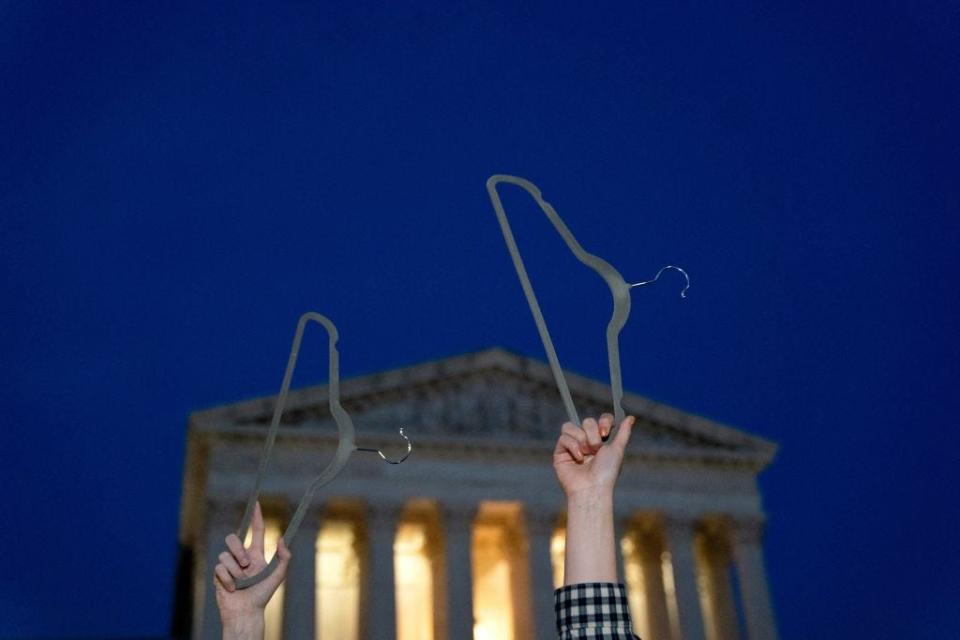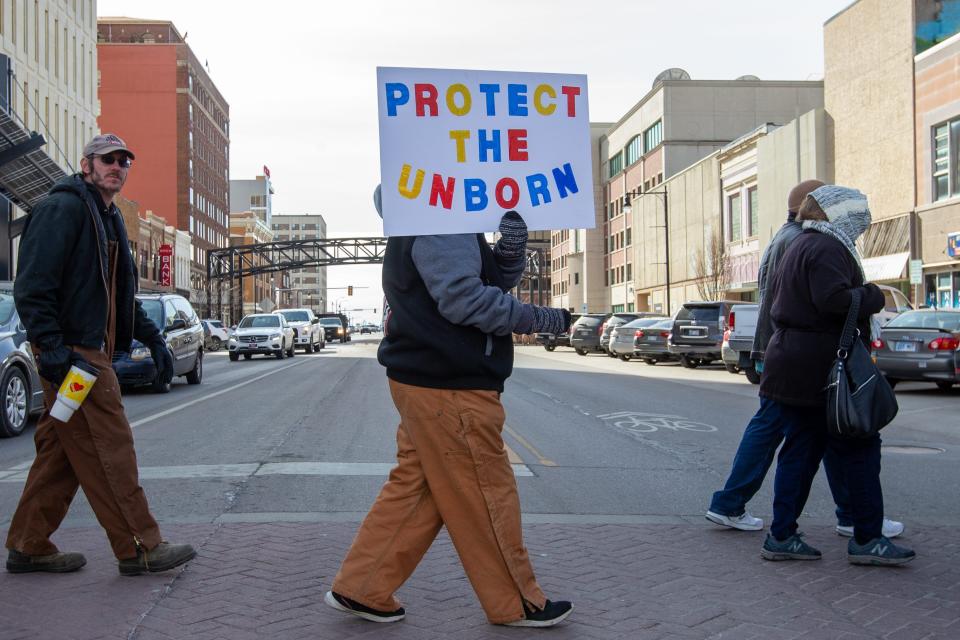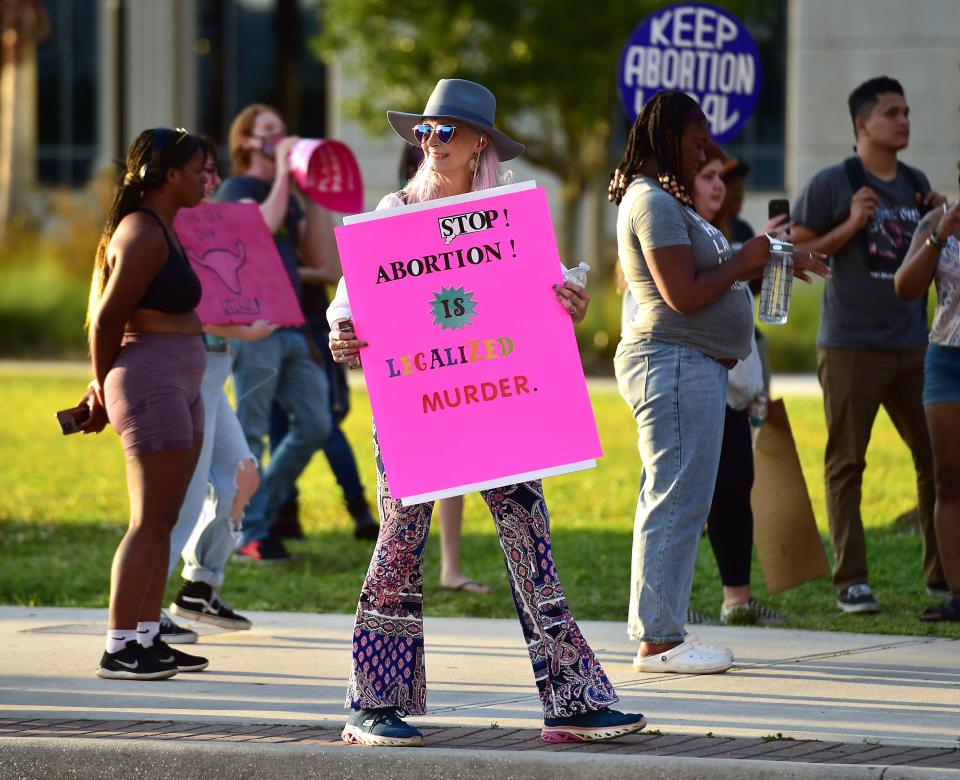Abortion rights groups have had a fundraising edge. Midterms to test if dollars can turn into votes.
When a draft Supreme Court decision that would overturn the landmark abortion rights case Roe v. Wade circulated this month, activists got to work rallying their bases.
NARAL Pro Choice America, which along with allies had already promised to spend $150 million to influence the upcoming midterm elections, sent out fundraising emails asking for emergency donations.
Students for Life Action, which takes credit for helping pass 18 different state laws limiting abortion aside from Mississippi’s 15-week abortion ban that is now in front of the Supreme Court, saw more money come in and announced a transition to a 50-state plan.
In the race for campaign money, the abortion rights side has long been winning, but the anti-abortion side has recruited people to stand outside abortion clinics and used that same grassroots support to back state laws restricting abortion.
Abortion: Anti-abortion groups could win a 50-year fight. They aren't stopping there.
Headed into the 2022 midterms, Republicans are trying to seize on an opportunity to take the majority in the House and Senate. Typically, the party that does not hold the presidency often prevails in midterm elections, and Democrats face headwinds with President Joe Biden's low approval ratings and high inflation.
But the leaked opinion could be a boost for the abortion rights side, experts say.
“Big events that tend to scare one side or the other tend to be really good for fundraising and so you can expect a decision overturning Roe to be a massive boost to groups on the abortion rights side of the spectrum,” said Ian Vandewalker, senior counsel at New York University’s Brennan Center for Justice.
“Having a big scary focal point seems to be a better fundraiser than having a big positive focal point,” he said.
Roe v. Wade: Why was Roe v. Wade never codified in Congress? Democrats 'kind of dropped it'

Abortion rights fundraising. Anti-abortion laws.
In the past two decades, abortion rights political action committees have outraised anti-abortion PACs by a two-to-one margin, according to an analysis of fundraising data from Open Secrets, a nonpartisan group that tracks money in politics.
From 1990 to 2022, abortion rights committees like Planned Parenthood raised $56.8 million, while anti-abortion groups like Susan B. Anthony’s List raised $28.2 million. Since the 2018 fundraising cycle, during which Mississippi passed its 15-week abortion ban, abortion rights committees raised $23.4 million, compared to $9.5 million for anti-abortion groups.
Those numbers are conservative because they do not include fundraising by Emily’s List, a left-leaning group that supports candidates who broadly support women’s issues including abortion rights. Emily’s List is one of the most prolific fundraising committees not affiliated with a party in the country.

“The pro-choice money is dominated by Planned Parenthood and its affiliates, and then by Emily's List,” said Pete Quist, deputy research director at Open Secrets. “Planned Parenthood, of course, works on other issues as well. This includes other areas of family planning and reproductive health, such as research on certain cancers, and that broader work may help explain some of its large fundraising.”
At the state level, abortion rights groups including Emily’s List spent $10.8 million in state elections from 2019 to 2022, and anti-abortion groups spent $384,000, according to Open Secrets. Despite that spending, in the past two years, state legislatures in Texas, Idaho, Arizona, Oklahoma, Kentucky and Florida have passed laws restricting abortion.
Experts said that money from political action committees does not fully capture how much is spent because the Republican Party and Democratic Party have aligned themselves closely with anti-abortion candidates and abortion rights candidates, respectively.
“If basically every GOP politician is anti-abortion, then every dollar supporting the GOP – including the pro-business giving that’s supposedly not motivated by culture wars – is supporting anti-abortion policies,” Vandewalker said.
Single-issue support
The anti-abortion side has been successful at mobilizing supporters around a single issue, while the abortion rights side has not always been able to connect the top of the movement to the bottom of the movement, experts said.
“The Republican Party has become increasingly dependent on anti-abortion or anti-abortion voters, particularly in the Trump era,” said Mary Ziegler, a visiting professor at Harvard University who specializes in the legal history of reproduction.
“That means that Democrats often have a variety of issues they care about, and while they care about this, I don’t think people think this is their main issue,” she said. “Whereas for many anti-abortion or anti-abortion voters they’re single-issue voters, this is the reason they show up at the polls.”
Justice Alito: Justice Alito's history of abortion in leaked draft is debatable, experts say.
At the same time, Ziegler said money on the abortion rights side led to a professionalization of the movement, where people at the top hire focus groups and perform polls, leading to a disconnect between elites and the grassroots, especially people of color.
“If you have all the money in the world and you don’t know what to do with it, or you don’t use it effectively, it doesn’t matter,” she said.

Shawn Carney, the president of the Texas-based nonprofit organization 40 Days for Life, called Planned Parenthood “a goliath” that does not understand grassroots supporters. His group's volunteers pray outside local clinics and encourage women to change their minds on abortion.
“I think they’ve forgotten that abortion doesn’t happen on the bench of the Supreme Court or in the White House or in the halls of Congress,” Carney said. “It happens in these neighborhoods.”
Gretchen Ely, a social work professor at the University of Tennessee–Knoxville, who has counseled women before they receive abortions, said she has interacted with protesters outside clinics and noticed a combination of misinformation and dedication.
“I would describe the anti-abortion effort as one of our modern but original disinformation campaigns,” Ely said. “Prior to what we’re seeing now with social media and maybe things that are going on around COVID for example, the anti-abortion movement has been at this since Roe v. Wade was instituted."
14th Amendment: What is the 14th Amendment and what does it have to do with Roe v. Wade?
Money is pouring into the abortion rights side.
The abortion rights side has seen a surge of donations following the leaked Supreme Court draft, but it’s an open question whether or not the money or the issue itself can mobilize people to vote for Democrats at the ballot box.
The Democratic fundraising platform Act Blue announced $12 million in fundraising in 24 hours, and Planned Parenthood urged followers to join local protests.
This was on top of efforts already in place, such as the announcement hours before the leak that NARAL Pro Choice America, Planned Parenthood Action Fund, and Emily’s List planned to spend $150 million in the midterm elections to elect abortion rights candidates up and down the ballot.
The money was also in addition to the tens of thousands of dollars each abortion rights groups gave to Democrats trying to keep their seats in battleground states, including Sens. Raphael Warnock of Georgia, Mark Kelly of Arizona, Maggie Hassan of New Hampshire, and Catherine Cortez Masto of Nevada.
Janet Yellen: Abortion is an economic issue, argues Treasury Secretary Janet Yellen
“This leaked opinion was really the latest and the most shocking example but it certainly didn’t come out of thin air,” said Kristin Ford, the vice president of communications and research for NARAL. “We are organizationally and as a movement really ready to meet this moment.”
Ford said her group will be heavily focused on voter mobilization and engagement, especially in states like Georgia, Michigan, Nevada, Oregon, and Pennsylvania. The spending commitment also blows out of the water the $5 million she said NARAL spent in the 2018 midterms.
Jenny Lawson, executive director of Planned Parenthood Votes, said in a statement that her group will be working to defend abortion rights in the upcoming elections.
“We expect, and have already seen, that voters will turn their outrage into action,” Lawson said. “The stakes for this election cycle are clearer than ever: abortion rights champions must be elected up and down the ballot in order to protect our fundamental freedoms.”
Richard Hall, a political science and public policy professor at the University of Michigan, said, “This is gonna be a shot in the arm for a lot of the pro-reproductive rights organizations. I don’t know whether or not there’ll be a counter-mobilization that’s really going to work for the anti-abortion groups.”
Abortion protests: Meet the groups organizing protests outside the homes of Supreme Court justices over Roe v. Wade
Students for Life, whose Mississippi chapters were key in supporting the law that is at issue in front of the Supreme Court, is experiencing increased donations and transitioning to a 50-state strategy, according to Kristi Hamrick, the spokesperson for Students for Life Action.
Hamrick said her group is active on more than 1,250 campuses in 50 states, and plans to engage in get out the vote efforts when most state legislative sessions resume.
The Republican fundraising platform WinRed did not respond to USA TODAY’s inquiry.
Will the abortion rights side be successful?
Experts said the leaked decision could motivate voters, but had differing opinions on whether it could motivate them enough to sway close elections for the House and Senate.
“Before, when Planned Parenthood said things are getting really bad, a lot of people didn’t believe them,” Ziegler said, “but now when the Supreme Court is set to overturn Roe and states are doing all this stuff, people look at that and say, ‘Well maybe it is going to get really bad.’”
Mark P. Jones, a political science professor at Rice University in Houston, said Democrats overstate how much abortion can drive people to the polls. He said the people most affected by a lack of widespread abortion access may not make it to the polls.
Abortion: McConnell calls US abortion ban 'possible,' says he won't change filibuster to pass it
“From a personal perspective, no male voter will have a reason to have an abortion and no female voter past a certain age will feel it, so it’s a small group that views it as a personal right as opposed to a group right,” Jones said.
In states that ban all or most abortions, women will still be able to get abortions in other states, as long as they can afford to travel there, Jones said. For women in Texas, that may mean traveling to Illinois or New Mexico. The women who can’t afford a plane ticket would be least likely to get abortions.
“Lower-income people who are sort of occupied with daily lives tend to turn out at very low rates,” Jones said. “So you’re left to people who are supporting it more in principle as opposed to purely instrumental personal benefits, which also weakens it as a mobilizational tool.”

Hall, from the University of Michigan, said races in battleground states and districts are already so well funded that money from abortion rights political action committees may not add enough for them to win.
“You can only run so many ads before they don’t make any difference anymore,” Hall said. “I think the way in which the reproductive rights organizations can matter is really by getting more, by increasing turnout.”
Contributing: Mabinty Quarshie.
This article originally appeared on USA TODAY: Abortion rights groups have outraised foes. Will it help in midterms?


